Proof of Keys- Steemit Crypto Academy- S4W7- Homework Post for @awesononso
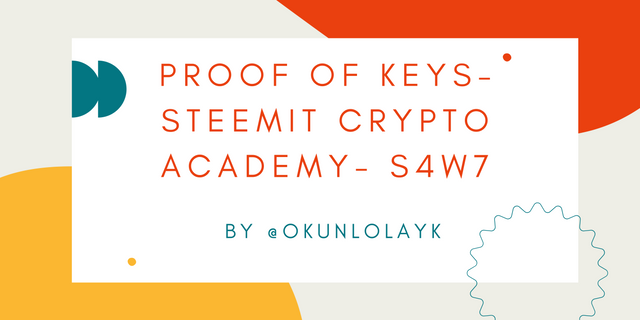
Image self created on Canva
Explain private and public Keys in relation to custodial and non-custodial wallets.
Cryptographic keys a are keys that are used to send messages in an unreadable format. The message is first encrypted at one end and the decrypted on the other end. Public and private keys are Asymmetric keys. They are a pair of related keys that encrypt and decrypt data. The public key can be publicly seen and are used to lock coin up into the wallet. The private key on the other hand can be used to unlock coins in the wallet. The holding of the private key proves the ownership of the funds of the wallet. A wallet could be custodian or non-custodian and these can be defined based on the who holds the private key. The Custodian wallet works in such a way that the private key is in custody of a third party. This is common to exchange wallete where users trust their funds and private keys in the hands of a custodian (the exchange). On the other hand the non- custodian gives users the privilege to hold their private keys. This gives the user an assurance of security of his funds. The private key is less likely to be crackable as they are made up of long bits which is infeasible to guess by a computer. This definitely secures the funds in the wallet.
What do you think about the Proof of Keys Day? What precautions would you take when participating?
The proof of keys day is a day set aside to sensitize and promote decentralization among blockchain users. This is somewhat like a bank run in the crypto ecosystem where users assure themselves of the ownership of assets they own. While I was young I listened to a folk story of a billionaire who has his billions stored up in his bank account. The bank claims he owns billions in their custody but one day to really believe himself as such, he walked up to the bank to withdraw a huge amount of his fund. This was offered to him in huge cash and afterwards he believed he own billions indeed.
The proof of keys day is a day when blockchain users assures themselves of the true ownership of what they claim to have. This can be done in pulling out one's fund out of a centralized wallet or custody and hold them personally on a Decentralized wallet.
When performing such withdrawal, one of the precautions is the safety of the private keys of your wallet. As mentioned earlier, your fund is as secure as the security of your Private key. Thus, it is wise to first consider the security of the private keys to the wallet you intend to keep your fund. Have it secured physically such as writing on a sheet of paper and keeping Privately where only you can visit it. Having taken funds away from the custodian(exchange), the security of such decentralized wallet now solely rests on the owner.
Secondly, it is good not to wait until proof of keys day before claiming ownership. This is because if all users of a centralized exchange place their withdrawal on the same day, it is most likely the company would not be able to fulfill all.
Centralized exchanges or Decentralized wallets for storing your cryptocurrencies? Why?
An Exchange is a platform where traders meet to exchange assets. This is a place where orders are matched. A buyer makes an order to buy a token in exchange for another token while on the other hand a seller makes an order to sell such token in exchange for the token the buyer wish to offer. An Exchange however brings these two parties together and have them fulfill their orders. In the light of this, an exchange can be Centralized or Decentralized.
The concept of centralization comes to play when the system is controlled by a central body or third party and Decentralization is just quite an opposite.
In a centralized exchange, activities or transactions are monitored and overseen by a third party. This means a such transactions involve the seller, the buyer and the moderator which happens to be the exchange organization. The third party is to see to security of asset and terms of agreement between the two traders. However, when using a centralized exchange, the user submit his assets to the exchange with no access to the private keys of the wallet holding such fund. As the common saying implies "not your keys, not your coin", a centralized exchange user does not hold the real crypto asset.
Decentralized wallet on the opposite gives users total custody of their coins. Users hold the real tokens and have the keys that secure the funds.
Both centralized exchange wallets and Decentralized wallet have their pros and cons and deciding which is preferable is at users' discretion. The centralized wallets are known to have a customer service network where complaints and report of fraudulent actions can be made. This gives the users some sense of security of their funds. They also provide a customer friendly interface experience that allows users to easily navigate their way while using their platforms. Centralized wallets also ensure credible trust of it's users as it's holds vital information about it's users through KYC (know your customer). Considering the disadvantages of the centralized wallet, if the users on the centralized exchange can be trusted, what about the exchange itself. The exchange which claims to secure funds for its users might not be faithful to their promises and play foul of their customers. They might have less real assets than what they claim to hold and this is why the "Proof of Keys Day" is considered an effective way to put them in check. The centralized wallets are also prone to hacks. They have all funds stored up to their database which attracts hacker that want to loot them away.
In contrast to the centralized exchange wallet, decentralized wallets holds no coin in a central wallet and users don't fall victims of hacks. Decentralized wallets does not use KYC and does not prove the identity or credibility of users on the network. It does promote total decentralization and freedom to own and use ones owned coin.
In a conclusive note, I prefer using decentralized wallet due to the fact that I can directly monitor my assets using my private key. Funds I wish to hold for a long time are well secured in my decentralized wallet (TrustWallet). TrustWallet is a good decentralized soft wallet and it has an inbuilt Decentralized Exchange (DEX) for easy swap of tokens. I as well use centralized exchange wallet (Binance) to procure quick trades and access features that are not readily provided by TrustWallet.
How I Transferred Steem from Binance Wallet to your Steemit Wallet.
Using the Binance mobile app, I have access to my binance wallet. I wish to send 25 steem to my steem wallet from binance wallet.
First, I went to my wallet and clicked on my steem holding. This shows options to deposit or withdraw. Since I'm sending out of my binance wallet to another wallet, it goes by withdrawal. Thus, I used the withdrawal.
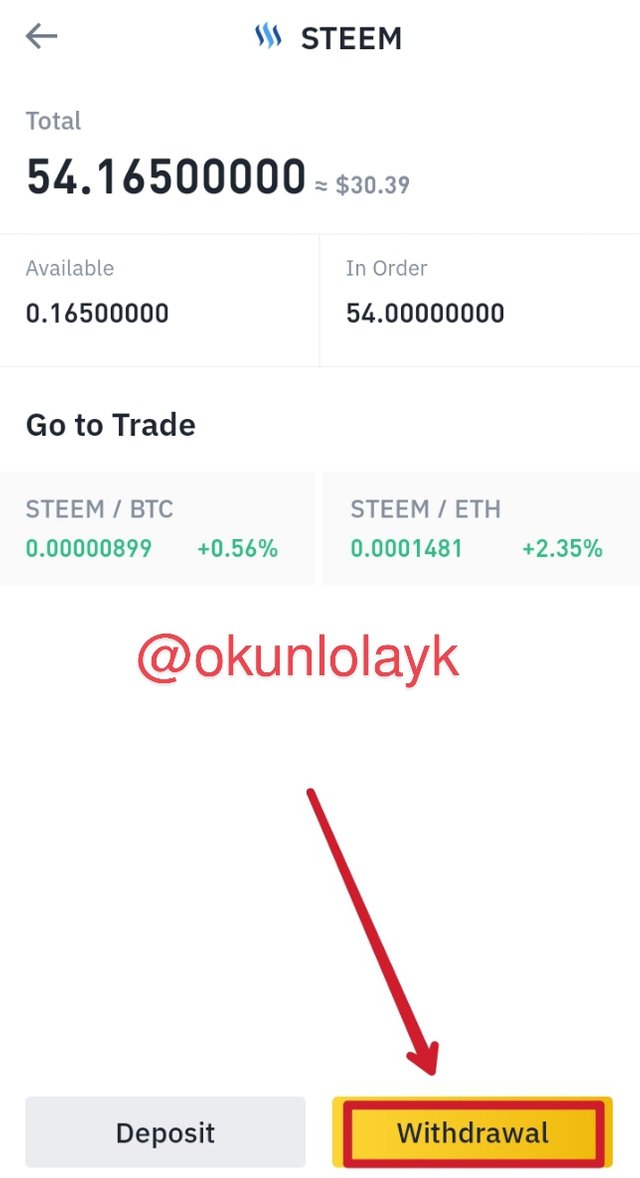
The withdrawal leads to a page to which the address of the recipient wallet is filled. In this case, the username of my steem wallet is provided and this automatically indicate that the address belongs to the steem space. I also filled in a memo which states "Homework" and the amount of Steem that I wish to transfer including the cost of transaction which is 0.01 steem. Then, click on withdraw.
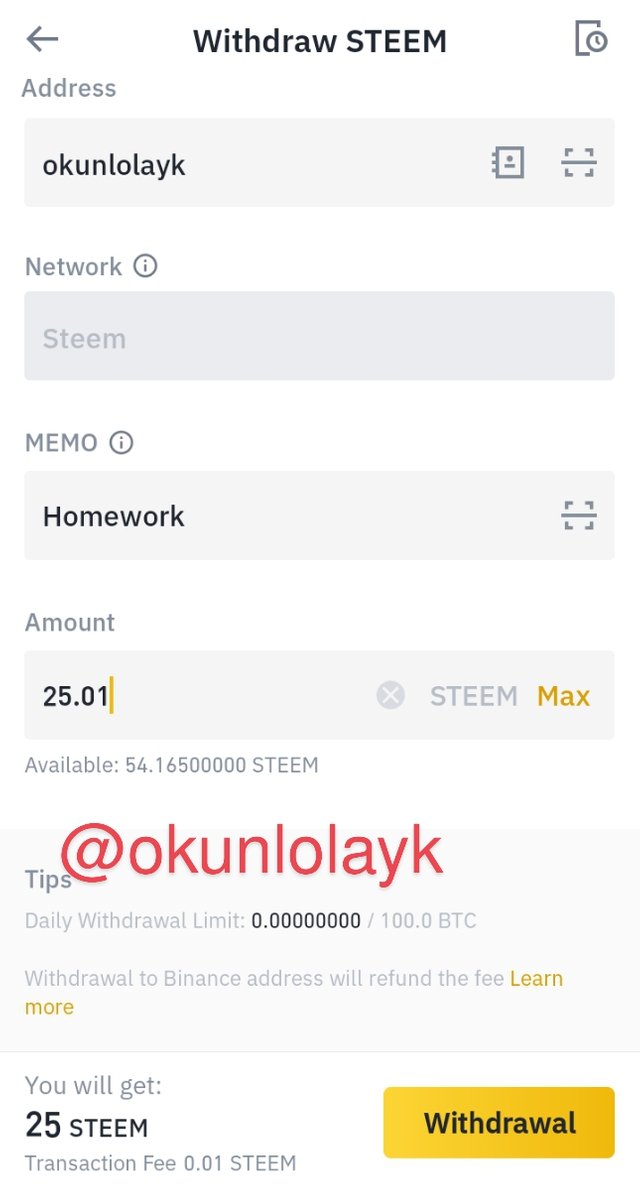
This brings up a confirmatory page in which I confirmed the details of the transaction, fill in security details and wait for approval.
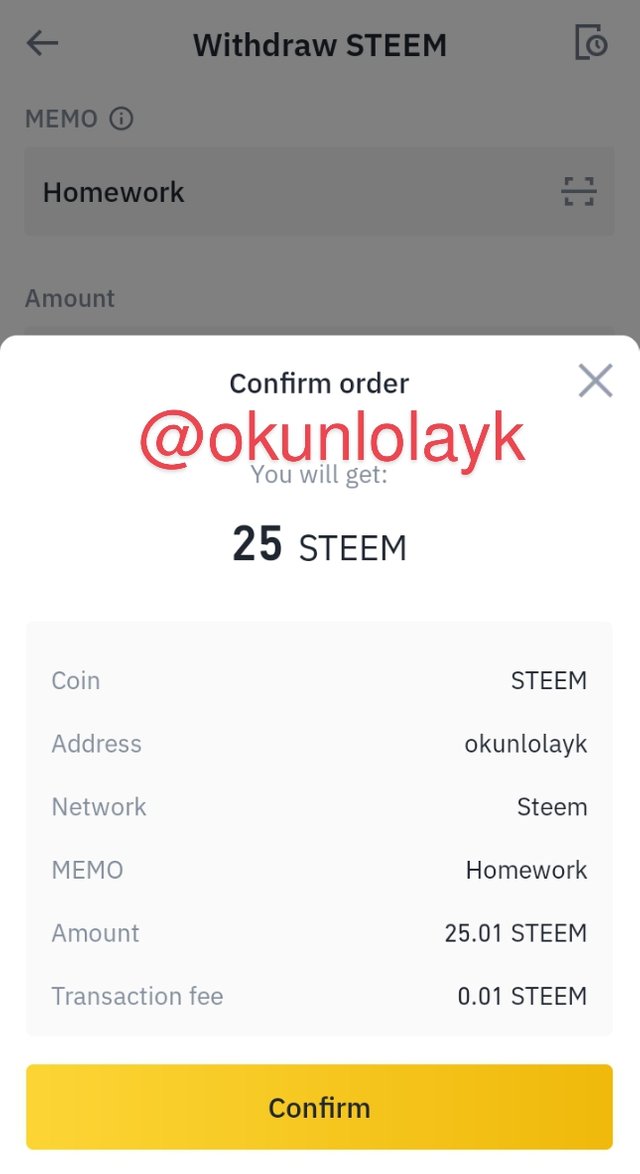
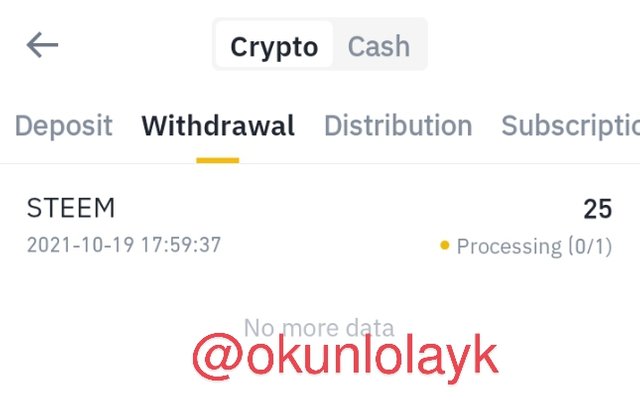
Here, I have the fund successfully deposited in my steem wallet.
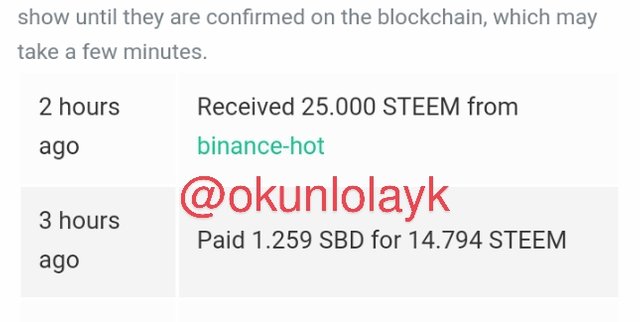
How I Transferred TRX from l Binance Wallet to TronLink Wallet.
A similar proceedure as above is followed to transfer 108.89 TRX from my binance wallet to my Tronlink wallet.
I clicked on my TRX holding in the Binance wallet and then click on withdrawal.
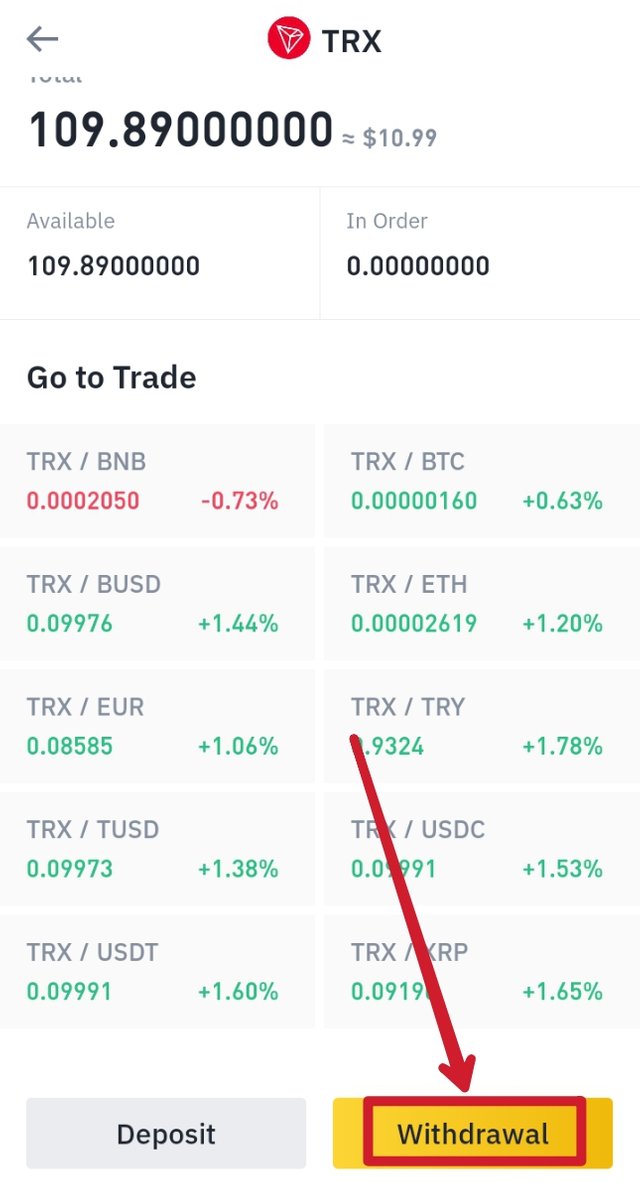
I proceeded to my Tronlink wallet to copy the address of my wallet. Here, I clicked the receive button and the copy the provided address.
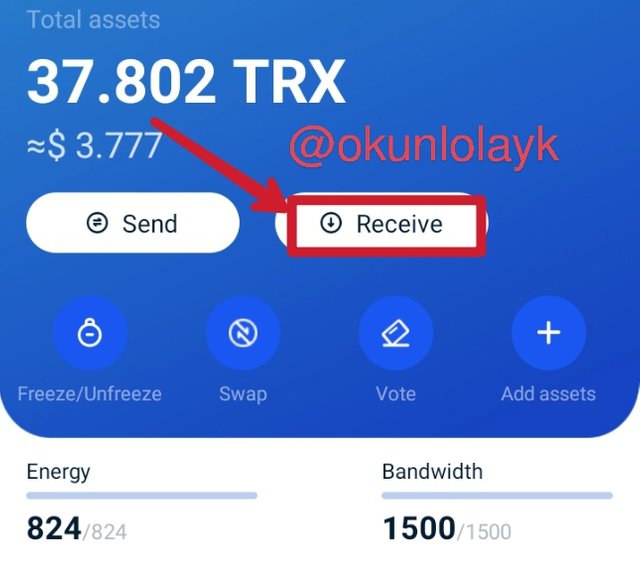
I returned to my binance wallet and filled in the recipient address which I copied earlier. This authomatically indicates that the wallet address belongs to the Tron System. I filled in the amount to be transferred and click on withdrawal.
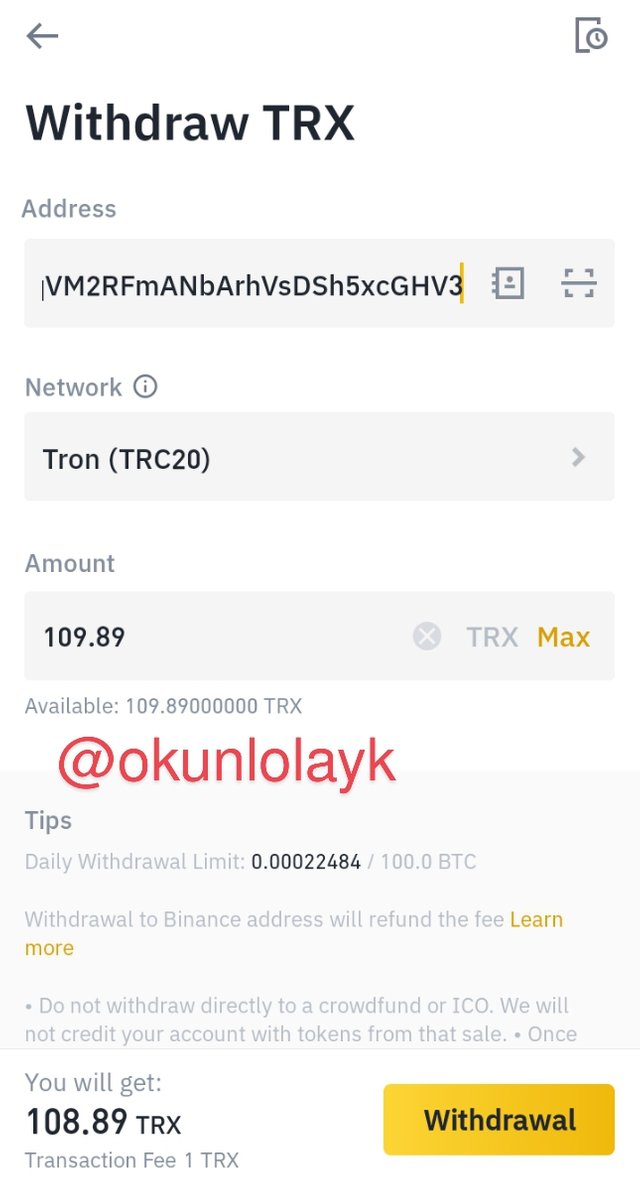
I confirmed the details of transaction and provide the security details. Thus I await approval and at last the TRX was deposited into my Tronlink wallet.
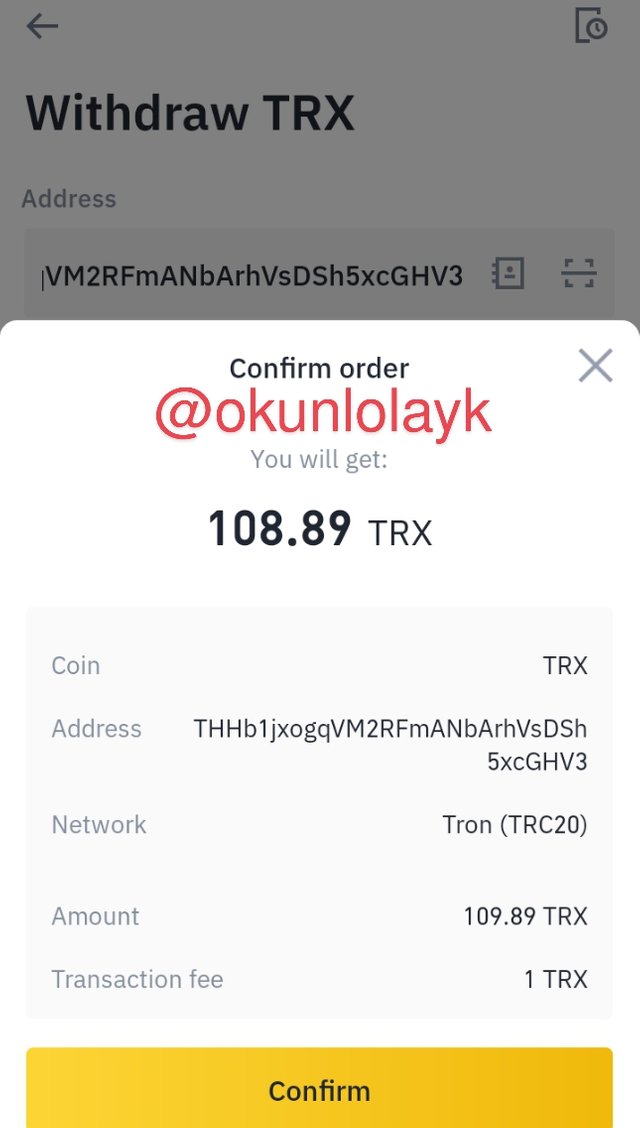
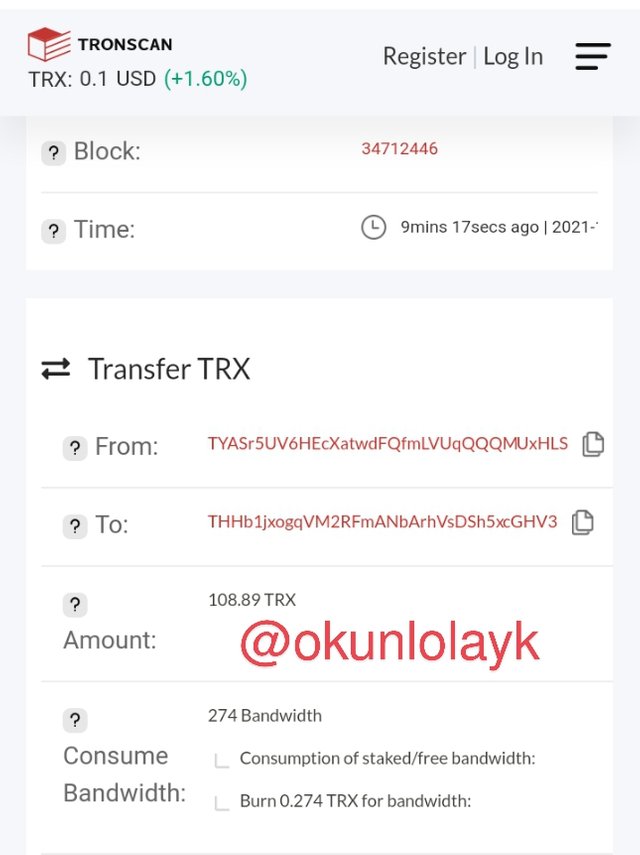
The Major Significance of the Transfers Above.
The significance of the transfer is to take to custody one's own token rather than having to depend on a Centralized system to keep such asset.
Conclusion
Decentralization is the system of the future and the journey began since the Genesis of the Blockchain technology. This has continue to evolve over time and improvements such as Decentralized Finance (DeFi) and Decentralized Applications (DApps) are offsprings of the advancement of Decentralization. And Yet "the best are yet be born"
Cc: @awesononso
Best Regards!!

Hello @okulolayk,
Thank you for taking interest in this class. Your grades are as follows:
Feedback and Suggestions
You should improve on your arrangement and markdown use.
You did not properly get the point in question 2.
Thanks again as we anticipate your participation in the next class.
Thanks so much for the assessment... Looking forward to writing a better one next time
#club5050 😀